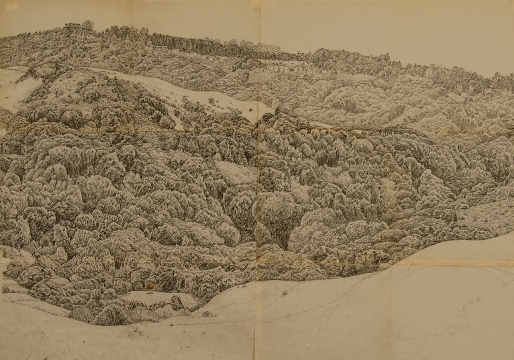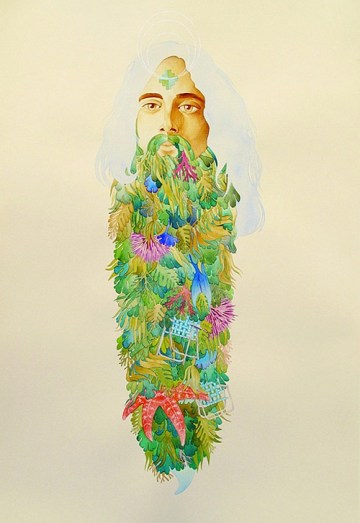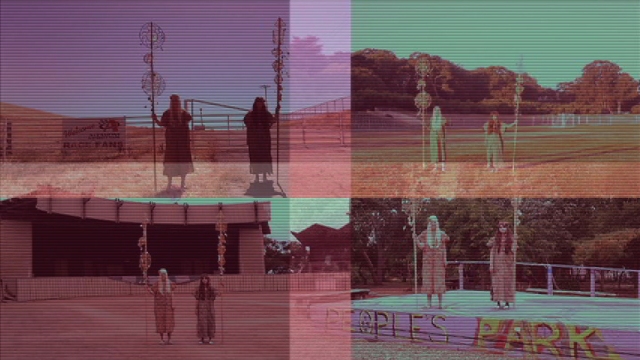
Postcard image from the writer's collection.
Many people in the East … have been to Los Angeles or to San Francisco, have driven through a giant redwood and have seen the Pacific glazed by the afternoon sun off of Big Sur, and they naturally tend to believe that they have in fact been to California. They have not been, and they probably never will be, for it is a longer and in many ways a more difficult trip than they might want to undertake, one of those trips on which the destination flickers chimerically on the horizon, ever receding, ever diminishing.
― Joan Didion, Notes from a Native Daughter (1965)
This is what I know of the state where I grew up: it is the size of a small country, with streets and towns named after Spanish priests, explorers, and ranchers. Summers are dry, winters green and lush, and spring arrives in February. Black-tailed deer cross roads at night, and suburban neighborhoods of ranch-style houses give way to hills. It is always hot in September. Go to Santa Cruz or Berkeley or Haight Street, and you will see that the hippies never left. Look backward to Ohio, Tennessee, or New Jersey: everyone you meet is from somewhere else.
I grew up twenty miles east of San Francisco in a semi-rural, upscale suburb; as such, my knowledge of California is both intimate and incomplete. I can describe the layers of smell given off by a pile of elm leaves, like the kind that accumulated in our driveway, but I have little to say about the sprawl of Los Angeles or the quiet farm towns of the Central Valley. Still, the yellow and brown leaves, I can tell you they smell just like bread beginning to mold―warm, layered, and a little rotten, like the state itself.

Postcard image from the writer's collection.
California’s legacy mixes expectations and innovations with disappointments and catastrophes. Its abundant resources, stunning landscape, and mild climate led some early explorers to think the place was a paradise; subsequent generations have fallen for the same hoax. The state has come of age through its multiple booms and busts. When gold was discovered in the Sierra foothills, men rushed here, risking everything they had for the possibility of what they could have. Those who didn’t strike it rich turned sour, and many left the state. People kept coming though, drawn by California’s promise. In the 1960s, media coverage of a series of student protests at UC Berkeley attracted dissatisifed and idealistic teenagers from across the country. Today, as Kevin Starr notes in his book California (UC Press, 2005), tech start-ups — companies that could be either the next Facebook or the next tech company nobody remembers— attract computer programmers like they are made of gold.

Postcard image from the writer's collection.
Despite this constant influx, the state always seems to be on the verge of collapsing. Right now, California is over twenty-five billion dollars in debt, and our unemployment rate is 12.4 percent, almost three points higher than the national rate. [2] Our outgoing governor is better known for his achievements as the Terminator and a bodybuilder than as a politician. Our incoming governor, Jerry Brown, is nicknamed “Moonbeam.” People move here after graduating college with plans to pursue careers, and five years later, they end up listing “palmistry” on their resumes as one of their skills. I can’t explain it; I am habitually overwhelmed.
Somehow though, amidst this instability, several young Bay Area artists are creating work that renders this wild and unknowable place visible and intelligible. They draw from the state’s powerful landscape, its history of mysticism and activism, and the surreal and not inaccurate sense that things are possible here that are not possible anywhere else.

David Wilson, "Heal," (detail) 2008. Charcoal pencil on found paper, 42" x 144". Courtesy the artist.
David Wilson, originally from Massachusetts, pays an almost devotional level of attention to the landscape of the Bay Area in his drawings and social gatherings, encouraging viewers to also be hikers, environmental observers, and participants. From his home in Oakland, he turns his eye to the hills at the city’s edge, highlighting the permeable boundary between nature and culture.

Gina Tuzzi, "Silver and Gold (2000)," 2009. Acrylic on paper. Courtesy the artist.
Gina Tuzzi, raised in the coastal town of Santa Cruz (the setting for 1987’s adolescent hippie vampire movie, The Lost Boys), fuses California coastal culture with counterculture in her paintings, drawings, and sculptures, investigating the cultural history and personal meaning embedded in the visual culture of the 1960s and ’70s.

Carol Anne McChrystal and Keturah Cummings, "Nightmare City. All that Is Solid Melts Into Air" (still), 2010. Multimedia. Courtesy the artists.
Carol Anne McChrystal and Keturah Cummings work as the artist collective Nightmare City, creating videos and sculptures that comment on the overuse of cultural signifiers and their resulting loss of meaning. A recent body of work, All that Is Solid Melts Into Air, focused particularly on the contemporary nostalgia for 1960s activist imagery in Bay Area art and culture and investigates how this uniquely Californian legacy manifests itself in a digital age.
In my contributions to the Art21 guest blog, I will discuss the work of these two artists and this one artist collective whose respective paintings, drawings, and videos thoughtfully reflect California―its periods of serenity and turbulence. Somehow, through their depictions, the ground seems to stop moving under my feet.




Pingback: The Beard | Stephanie Vegh